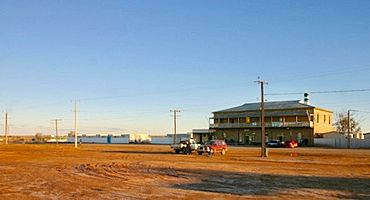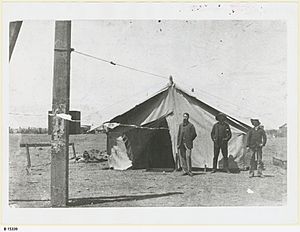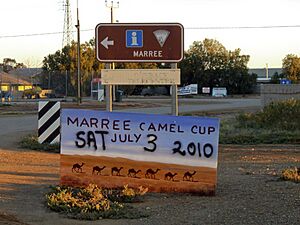Marree, South Australia facts for kids
Quick facts for kids MarreeSouth Australia |
|||||||||||||||
|---|---|---|---|---|---|---|---|---|---|---|---|---|---|---|---|

Marree Hotel
|
|||||||||||||||
| Established | 20 December 1883 (town) 29 May 1997 (locality) |
||||||||||||||
| Postcode(s) | 5733 | ||||||||||||||
| Elevation | 50 m (164 ft)airport | ||||||||||||||
| Time zone | ACST (UTC+9:30) | ||||||||||||||
| • Summer (DST) | ACST (UTC+10:30) | ||||||||||||||
| Location |
|
||||||||||||||
| LGA(s) | Pastoral Unincorporated Area | ||||||||||||||
| Region | Far North | ||||||||||||||
| State electorate(s) | Stuart | ||||||||||||||
| Federal Division(s) | Grey | ||||||||||||||
|
|||||||||||||||
|
|||||||||||||||
| Footnotes | Locations Adjoining localities |
||||||||||||||
Marree (/mɑːˈriː/ MAH-ree) is a small town in the north of South Australia. It is about 589 kilometres (366 miles) north of Adelaide. Marree sits where two famous outback roads meet: the Oodnadatta Track and the Birdsville Track. It is 49 metres (161 feet) above sea level.
Marree is an important place for the big sheep and cattle farms nearby. It is also a popular stop for tourists exploring the outback. The Dieri Aboriginal people have lived in this area for a very long time. Most jobs in Marree are in farming, mining, and looking after tourists.
The town was once home to Australia's first mosque. It was built from mud bricks by Afghan cameleers. These cameleers worked with camels to transport goods across the desert. In the early 1900s, the town was divided. Europeans lived on one side, and Afghans and Aboriginal people lived on the other.
Marree's Past and Name
The first European explorer to visit the Marree area was Edward John Eyre in 1840. Later, in 1859, explorer John McDouall Stuart came with a German botanist named Joseph Herrgott. Herrgott found some springs, and Stuart named them after him.
The area was first called Herrgott Springs. The town's post office also used this name when it opened in 1883. In 1911, a nurse named Clara Winifred Howie came to set up a nursing station there.
The town's name was changed to Marree in 1917. This happened during World War I because people felt strongly against anything German. The name Marree is believed to come from an Aboriginal word.
Some famous movies have been filmed in Marree. These include The Rover (2013), parts of The Inbetweeners 2 (2014), and Last Cab to Darwin (2014).
Early Transport and Communication
The Central Australia Railway reached Marree in 1883. The first train arrived at the station in January 1884. A telegraph and post office opened in Marree in June 1884. At first, it was in a canvas tent. Later, a proper building was built.
Marree became a key place for the cattle industry. Trains would take cattle from Marree to other parts of Australia. The railway line was extended north from Marree. It reached Alice Springs in 1929. This was part of the route for the famous passenger train called The Ghan.
In 1957, a new, wider railway line was built south from Marree. This line helped move coal from the Leigh Creek Coalfield. Because of this, Marree became a "break-of-gauge" station. This meant trains had to change from a narrow track to a wider track.
In 1980, the narrow track from Marree to Alice Springs closed. A new, wider line was built much further west. By 1987, the railway line to Marree was completely closed. The town no longer had a train connection.
Marree was also the home of Tom Kruse. He was a famous mailman who drove trucks from Marree to Birdsville. This trip was about 700 kilometres (430 miles) long. It crossed very tough desert land. It was amazing that fully loaded trucks could make the journey. You can see many photos and items from Tom Kruse's mail run at the Marree Hotel.
The Marree Man
In 1998, a huge chalk figure was found etched into the ground. It was about 60 kilometres (37 miles) west of Marree. People called it the "Marree Man." Some wanted it to become a state symbol. However, local people preferred to let it slowly fade away naturally.
Climate in Marree
Marree has a very hot and dry climate. It is in a desert area. Temperatures can go above 40 degrees Celsius (104°F) from October to April. Rain is very rare and unpredictable. When it does rain, it's usually in short, heavy downpours. This happens only a few times a year.
| Month | Jan | Feb | Mar | Apr | May | Jun | Jul | Aug | Sep | Oct | Nov | Dec | Year |
|---|---|---|---|---|---|---|---|---|---|---|---|---|---|
| Record high °C (°F) | 49.4 (120.9) |
47.9 (118.2) |
46.1 (115.0) |
40.1 (104.2) |
34.0 (93.2) |
30.1 (86.2) |
29.6 (85.3) |
35.0 (95.0) |
39.5 (103.1) |
43.7 (110.7) |
47.5 (117.5) |
49.0 (120.2) |
49.4 (120.9) |
| Mean daily maximum °C (°F) | 38.0 (100.4) |
36.8 (98.2) |
33.9 (93.0) |
28.5 (83.3) |
23.2 (73.8) |
19.6 (67.3) |
19.1 (66.4) |
21.5 (70.7) |
25.8 (78.4) |
29.6 (85.3) |
33.3 (91.9) |
36.1 (97.0) |
28.8 (83.8) |
| Mean daily minimum °C (°F) | 21.5 (70.7) |
21.1 (70.0) |
18.1 (64.6) |
13.3 (55.9) |
9.0 (48.2) |
6.0 (42.8) |
4.9 (40.8) |
6.4 (43.5) |
9.8 (49.6) |
13.4 (56.1) |
16.9 (62.4) |
19.5 (67.1) |
13.3 (56.0) |
| Record low °C (°F) | 10.0 (50.0) |
10.6 (51.1) |
7.8 (46.0) |
2.8 (37.0) |
0.0 (32.0) |
−2.8 (27.0) |
−2.8 (27.0) |
−1.4 (29.5) |
−1.1 (30.0) |
1.0 (33.8) |
7.2 (45.0) |
10.2 (50.4) |
−2.8 (27.0) |
| Average precipitation mm (inches) | 17.3 (0.68) |
21.5 (0.85) |
14.3 (0.56) |
11.0 (0.43) |
13.3 (0.52) |
13.6 (0.54) |
9.9 (0.39) |
9.1 (0.36) |
10.6 (0.42) |
12.9 (0.51) |
11.8 (0.46) |
16.4 (0.65) |
161.7 (6.37) |
| Average precipitation days | 2.3 | 2.2 | 1.9 | 1.9 | 2.5 | 3.0 | 2.6 | 2.5 | 2.4 | 2.8 | 2.7 | 2.5 | 29.3 |
| Average relative humidity (%) (at 3pm) | 21 | 26 | 25 | 31 | 39 | 44 | 41 | 34 | 29 | 25 | 23 | 21 | 30 |






